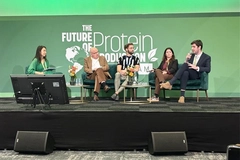International and BBQ flavors predicted to boom in 2022, reveals Dutch Spices
05 Nov 2021 --- Dutch Spices has revealed its trend report for BBQ flavors in 2022. The emphasis is on developments in the food landscape, specific BBQ trends and taste directions. According to the company, flavors from different parts of the world are rising, specifically flavors from Asia, the Middle East, South America and the Mediterranean regions.
Speaking to FoodIngredientsFirst, Betty Groen, marketing advisor at the company, believes meat alternatives will expand into new territories in spice innovation.
“We have new blends suitable for vegan, halal-friendly and allergen-safe food concepts,” she explains.
“There is a concept called the ‘carrot dog,’ where a carrot replaces a hot dog. In this format, flavors are combined, maybe with avocado and the flesh is mixed with a tomato salsa sauce and a smokey blend. This combination of spicy and smoke is delicious as a dipper with tortilla chips or bread.”
Spice flavors heat up
Meanwhile, Groen also highlights several burger concepts based on regional flavor combinations, including a spicy, Mediterranean, and smokey burger.

 Flavors from different parts of the world are rising, including flavors from Asia, the Middle East, South America and the Mediterranean regions.Skewers for prawns with a Thai red curry marinade, chicken shashlik with an Argentina marinade, and bacon skewer with a black pepper marinade are concepts Dutch Spices have been developing.
Flavors from different parts of the world are rising, including flavors from Asia, the Middle East, South America and the Mediterranean regions.Skewers for prawns with a Thai red curry marinade, chicken shashlik with an Argentina marinade, and bacon skewer with a black pepper marinade are concepts Dutch Spices have been developing.
“From the US specifically, smokey, Italian, cheese flavors will appear more frequently in Europe,” continues Groen. “Middle East blends such as harissa and ras el hanout will also drive development as well as South American flavors including chimichurri and cheese. In a nod to Asian flavors, miso and wasabi will also rise.”
Grilling traditions evolve
BBQ concepts for meat, prawns and fish are permanent, affirms the company, noting how the consumer “wants to be surprised with taste, but they also want to preserve traditions.”
Some examples of concepts that will become popular in 2022 are rubbed tomahawk with a caramelized onion chutney: the meat on the bone is seasoned and cooked on the BBQ.
When you taste the meat with the caramelized onion chutney, you immediately understand why these flavors go so well together, says Groen. “As a variation, a rib-eye (without the bone) or a sukade-lap can also be used. A concept in which multiple flavors from different parts of the world are combined. Think Thai-style skewers, such as marinated tiger prawns with lemongrass chili marinade or red curry marinade. These skewers become an eye-catcher on the BBQ.”
Meanwhile, Mediterranean flavors also go well with BBQ sausage, chicken or pork.
“Burgers remain nice and juicy through a mixture of the fiesta Provenza spice mix and the tomato salsa sauce,” adds Groen.
Eye on food waste
According to Dutch Spices, food waste will remain a relevant topic in 2022, with a boom in initiatives targeting environmental sustainability and the reduction of carbon footprints.
“We will see this in the entire chain of hospitality, retail and consumer-driven services,” adds Groen.
Climate change due to greenhouse gas emissions is on the political agenda. It is clear how much CO2 emissions the various product groups cause.
“Animal products, in particular, emit a lot. Dairy substitutes contribute more than dairy. Cultured meat is seen as a superior alternative,” says the company. Consumers want to be surprised with taste, but they also want to preserve traditions,” says Dutch Spices.
Consumers want to be surprised with taste, but they also want to preserve traditions,” says Dutch Spices.
Macroeconomic developments
Dutch Spices has seen an increase in purchasing power for several years in a row (+2.2% in 2020). Last year, retail turnover increased by almost 6%, the company reveals.
Within this, the supermarkets even showed an increase of 7.1%. The growth in online purchases is also largely due to the COVID-19 pandemic.
Major problems that impact the household wallet will not be addressed, and many households will no longer have to spend in 2022. On top of that, there is an increase in energy costs and raw material costs.
Consumer and retail demands
The hybrid consumer expects food on demand and is increasingly opting for premium products with a unique taste and experience.
The additional cost is acceptable with an added value. In the retail landscape, there are shifts due to the disappearance of supermarket formulas. This increases purchasing power and economies of scale, says Dutch Spices.
By Elizabeth Green
















